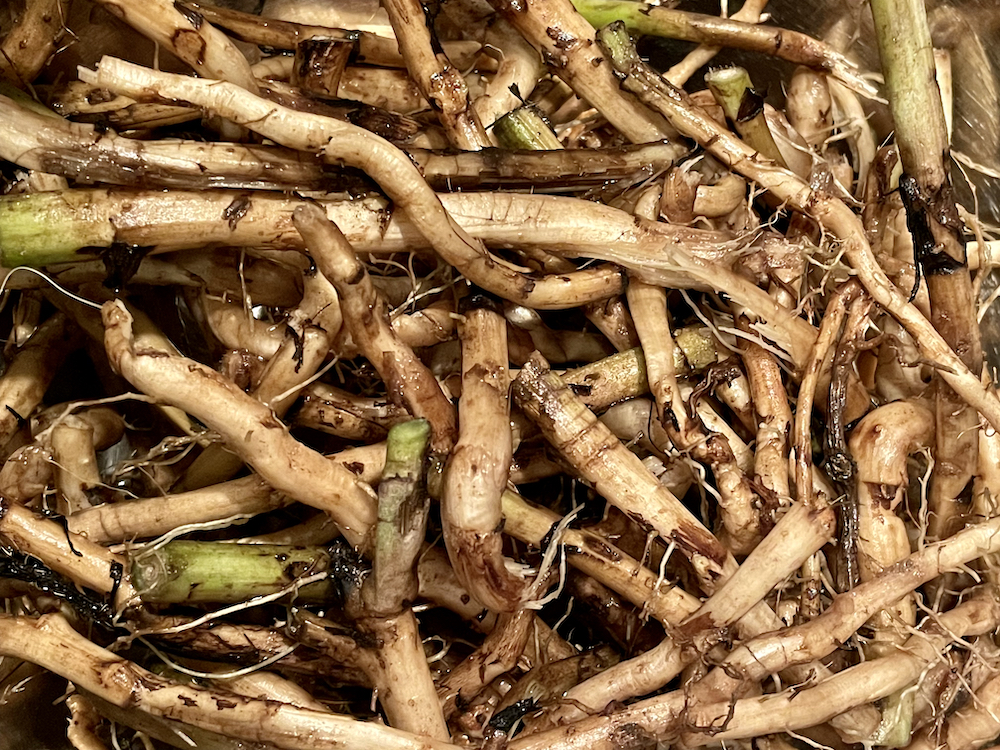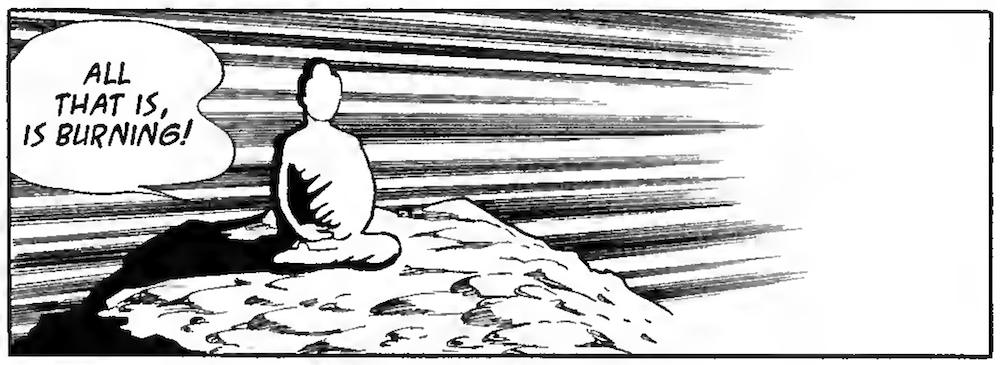Wabi-sabi, a concept in Japanese aesthetics revolving around the beauty of imperfection and impermanence, aligns well with both the goblincore aesthetic and subculture and some of J.R.R. Tolkien’s short, hairy creatures.
Autumn has always been my favorite time of year. The greenery slowly transforming into hues of red-orange copper and yellow. The beautiful decay cluttering the ground in varying shades of brown. The crisp breeze heralding the seasonal shift. Bites of frost and dreary skies foreshadowing the darker, colder months ahead.
I love it.
It’s also a rather dirty time for me in the garden and out foraging. Aside from any frost-surviving berries that need to be picked, late autumn is also one of the best times to stir up the soil and start digging for nutrient-filled taproots and tubers amid confused earthworms and millipedes. And one of the things digging in the cold, autumn dirt always bring me back to – more so than the fresh scents and sunny-scapes of springtime garden prep and foraging for early greens and vernal flowers – is a raw connection to the earth and what really characterizes it.

A concept in Japanese aesthetics I’ve come across in my research on Buddhist philosophy and wildcrafting that aligns perfectly here is wabi-sabi. Although the concept often escapes universal definition, and is instead typically defined through intuitive response, Leonard Koren succinctly captures the gist of it in Wabi-Sabi for Artists, Designers, Poets & Philosophers (2008): “Wabi-sabi is a beauty of things imperfect, impermanent, and incomplete. It is a beauty of things modest and humble. It is a beauty of things unconventional” (p. 7). I like Beth Kempton’s take on it as well in Wabi Sabi: Japanese Wisdom for a Perfectly Imperfect Life (2019): “Wabi sabi is an intuitive response to beauty that reflects the true nature of life. Wabi sabi is an acceptance and appreciation of the impermanent, imperfect, and incomplete nature of everything. Wabi sabi is a recognition of the gifts of simple, slow, and natural living” (p. 5). Specific rhetoric aside, the idea here is that the world and its beauty is recognized and appreciated as it really is – not relegated as something needed to be perfected, completed, or improved. It’s about simple living. It’s about mindful appreciation. It’s about recognizing that change characterizes everything. It’s about being happy and content without attachments to unnatural ideals and circumstances.
In a world that has always increasingly been precessed by simulacra and the appearance of the real – our digital, performative lives simply offering a more contemporary context for such façades – we can see how the notion of wabi-sabi might be both beneficial and refreshing in today’s cultural climate. Indeed, various social movements and culture-jamming theatrics have attempted to tear down societal blinders on a regular basis – especially during the past hundred years (see previous remarks concerning the Situationists, for example, in terms of critical remix and their influence on punk ideology). But a more recent aesthetic and subculture emerged during the height of SARS-CoV-2: goblincore.
Goblincore is all about embracing the parts of nature that are far less appreciated in day-to-day life, if not outright undesirable – from insects, snails, frogs, bats, crows, and mushrooms, to rocks, animal bones, moss, trees, dried flowers, inconspicuous botanicals, the dirt under our toes and fingernails, and the dark, earthen hues that characterize all of these. It’s often defined in contrast to cottagecore – an oppositional, yet complementary, aesthetic typically framed as a romanticization of rural life (and criticized as rather unrealistic). It’s apparent in the sourdough-baking, jam-canning, chicken-raising foray into homesteading that skyrocketed during quarantine, while most of the world was working from home or dealing with unfamiliar free time while navigating unemployment. Morgan Sung captured it well in a piece for Mashable a couple years ago: “Cottagecore is characterized by a deep desire to escape a metropolitan life for a slower, pastoral one. The cottagecore aesthetic has its faults, and has been criticized for romanticizing a colonialst [sic] mindset of homesteading, but the desire for a less frantic way of existing permeated American homes throughout quarantine. A cottagecore lifestyle involves waking up to sunlight streaming through lacy curtains, tending to your chickens, and if the day is particularly exciting, perhaps picking berries for homemade jam. The greatest appeal of cottagecore is that nothing really happens.”
Goblincore, however, is less about “frilly white aprons” and more about a “dirt-stained counter.” As in, it’s about how that countertop really looks after a long, hard day of homesteading – not the idyllic fantasy that working outside and in the dirt all day is one of the cleanest and flattering activities imaginable. At its core, it’s about things as they are and embracing those things around us in celebration of such qualities, regardless of societal expectations or standards of beauty. Imperfection, in other words, is key. As Sara Li reports, odd socks, messy hair, and mud-stained skin and clothing are all celebrated in goblincore. Life, Kempton notes throughout her work, is “perfectly imperfect,” and that’s how it should be recognized and appreciated.
Kempton also makes a distinction between what wabi-sabi has started to signal in Western contexts and that intuitive, experiential meaning captured by its more philosophical foundations. For instance, it is increasingly used as an adjective to capture a specific taste: “It has come to represent a natural, rustic look, which honors imperfection, organic materials, textures, and character” (p. 33). It’s become, in these contexts, “a name for a particular look that celebrates imperfection and the mark of time, rather than appreciating its powerful depths” (p. 34). In other words, it’s become conflated with what might be associated with experiencing wabi-sabi, rather than the philosophical underpinnings of the aesthetic. She uses the term “wabisabiesque” in order to differentiate between such “visual taste” and an intuitive appreciation of deeper, the-world-as-it-is beauty, and goblincore illustrates what this distinction looks like quite well, too.
That “visual taste,” however, is still informed by a deeper intuition, of course, functioning as, what Koren states in his follow-up text, Wabi-Sabi: Further Thoughts (2015), an “aesthetic other” against “the dominant aesthetic convention” (p. 46). He notes (2008) that wabi-sabi “represents the exact opposite of the Western ideal of great beauty as something monumental, spectacular, and enduring.” We don’t find it among “bloom and lushness.” It has nothing to do with “gorgeous flowers, majestic trees, or bold landscapes.” It suggests “the minor and the hidden, the tentative and the ephemeral: things so subtle and evanescent they are invisible to vulgar eyes” (p. 50). “Where cottagecore is dreamy and idealistic, conjuring up images of flowing skirts and picking wildflowers,” writes Savannah Sher, “goblincore is more earthy and pure. The overall effect is cozy and natural, bringing a folksy warmth to any space. The hobbits of J.R.R. Tolkien’s fictional Middle Earth embody the trend quite well.”
Hobbits. Of course, right? Those stealthy little creatures in Middle Earth that fall somewhere between dwarf, human, and Silvan elf (well, that last one might be a tad generous). They’re certainly demonstrative of the wabisabiesque. Tolkien describes them in the prologue to The Fellowship of the Ring as unobtrusive lovers of peace, quiet, “good tilled earth,” and “well-farmed countryside,” who have a “close friendship with the earth.” We get the sort of serene pastoral vibe in scenes from The Hobbit and The Lord of the Rings, which Peter Jackson’s films brought to even greater visual appeal on screen. But I think this connection between hobbits, goblincore, and wabi-sabi really comes to life in The Lord of the Rings: The Rings of Power with the depicted Harfoots – one of the three ancestral “breeds,” alongside the Stoors and Fallohides, of the hobbits of Tolkien’s Third Age (the time period for both The Hobbit and The Lord of the Rings) – who are described by Tolkien as “the most normal and representative variety of Hobbit” and the preservers of “their ancestral habit of living in tunnels and holes.” I don’t think a connection to the earth gets any more direct than literally living in a tunneled hole in the ground.

In The Rings of Power, the first time we see the Harfoots, they’re coming out from hiding after travelers pass through the outskirts of their camp. They’re depicted as semi-nomadic foragers, traveling to different areas at certain times of the year. They’re relatively dirty with a sort of illustrated messy comfort that screams less “bath” than it does “snuggle,” wearing earthen tones to match their surroundings. During a migration trek that extends throughout multiple episodes, we see how they adapt their outward appearance to better blend into the terrain they’re crossing as well. Hobbits, Tolkien tells readers, are excellent hiders, if need be – with or without a shiny, precious ring.

Hobbits were also extensive collectors. In that same prologue, Tolkien describes their “Mathom-houses” as places meant to hold their various “mathoms” – “anything that hobbits had no immediate use for, but were unwilling to throw away” – because their homes became far too cluttered with all of the things they collected and “the presents that passed from hand to hand.” This is also one of the things that is specifically celebrated in goblincore: clutter. Collecting and scavenging for little trinkets, especially shiny gold or silver ones, lends it a sort of maximalist quality in terms of that appreciative connection to the earth and how it is being revered. And at first, this might seem like a major clash between it and the minimalist perspective of wabi-sabi, but such activity has less to do with the consumption of goods than it does with appreciating the world and its marvels by collecting what is already there. In this way, there is a sort of guided accumulation of what dazzles the eye and stirs a connection to one’s surroundings. There is a difference, then, between unrestrained collecting for clutter’s sake, and purposeful gathering of that which delights in a rather wabisabiesque way.
The extreme manifestation of this patterned behavior with little trinkets in Tolkien’s work, of course, was Gollum – a Stoor hobbit formerly known as Sméagol. Gollum’s precious ring was obviously at the center of Tolkien’s entire narrative, and his obsession with that little shiny object fits well with the goblin-as-collector trope. But Tolkien also includes actual goblins in his Middle Earth, who are nothing like the hobbits that seem to align so well with goblincore, making this correlation a bit…muddy. In other words, Tolkien’s wabisabiesque hobbits are more like the signified “goblin” in goblincore, resulting in Tolkien-specific framing in the context of Middle Earth: the hobbit-as-goblin. Perhaps we could avoid the risk for confusion and get away with something like “hobbitcore” instead?
But, taking a step out of Middle Earth for a moment and more explicitly coming back to the depth underneath the taste, wabi-sabi is also very much about beauty and appreciation through defamiliarization, which carries a noticeable subversive edge to it. The goblin-as-collector (or thief) who lives – or at least spends much time – in the woods frames goblincore as a subversive aesthetic that rejects societal norms and standards, and carries an anti-capitalistic sentiment that aligns with that love for nature as-it-is. “Goblins find capitalism revolting – and with good reason,” Danica Granado writes. “Capitalistic production has significantly contributed to the Earth’s destruction. Due to this economic system, the planet now faces various types of pollution, deforestation, and even loss of biodiversity. That said, taking part in goblincore goes beyond collecting its goth DIY trinkets or adopting its gritty fashion. Revering and taking care of nature is a response that goblins have developed against capitalism’s destructive facets.”
Koren (2008) links wabi-sabi to “the more emphatic anti-aesthetics that invariably spring from the young, modern, creative soul: beat, punk, grunge, or whatever it’s called next” (pp. 9-10). Goblincore (or hobbitcore, right?!), in this way, appears to continue in that lineage of pointed disruptive responses to societal shortcomings and destructive tendencies. When the ways we have been conditioned to look at things around us are subverted, Koren (2015) indicates – when imperfection is framed as the ideal – that’s when a profound shift in perspective takes place. “The beauty of wabi-sabi involves perceiving something extraordinary in something that might otherwise be regarded as quite ordinary, undistinguished, or barely there.” And just like those sneaky and adaptive Harfoots, “The distinctiveness of wabi-sabi comes from that which is so faint, tentative, delicate, and subtle that it may be overlooked – or mistaken as trivial or insignificant” (p. 49). After all, whoever would have thought that a hobbit would effectively become the savior of Middle Earth rather than a renowned – and much taller – leader?
Wabi-sabi reminds us to appreciate. To be mindful. To be aware. And to actually see. Celebrating imperfection through comfort, joy, honest expectations and assumptions, and connective experiences brings us closer together and closer to the ground we’ve been digging in since we first became self-aware. Trendy aesthetic movements work well in reminding us of this. So do new popular cultural narratives that excite decades-old fandoms again. And seasonal shifts do a remarkable job at reminding us of it as well – whether it concerns the interplay between the rustic and rust of deterioration, between death and new life, or between dormancy and vitality. The point is, everything is subject to change. And as a result, life is characteristically messy and dirty because of that. But rather than reject such conditions of our existence, we can embrace them and find solace rather than sorrow in them. And that is what wabi-sabi is all about.
Photograph of thistle root taken by author (2022). Images from The Lord of the Rings: The Rings of Power via Amazon Studios (2022).



